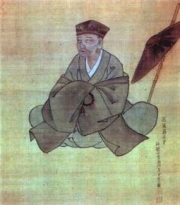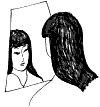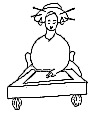TEACHERS (Primary) - Page 2

This is master Basho, the great Japanese poet who invented the haiku as we know it: a tiny poem filled with a love of nature. He spent his life close to nature. After a year in 1683 during which his hut burned down and his mother died, he took to the road. From the age of forty (in 1684) he travelled from place to place, like a tramp or wandering monk, walking through the countryside, living by teaching poetry in each town or village where he stopped.
His attitude to nature was humble, selfless, and deeply respectful. He said, "Go to the pine if you want to learn about the pine, or to the bamboo if you want to learn about the bamboo."
One of Basho's fans, a poetry student, came to him and said, "I've got a great idea for a poem! It goes: 'Pull the wings off a dragonfly, and look - you get a red pepperpod!'"
Basho said, "No. That is not in the spirit of haiku. You should write: 'Add wings to a pepperpod, and look - you get a red dragonfly!'"
Cruelty, violence and sensationalism have no place in haiku poetry. The natural processes of suffering and death do, but the attitude to creatures that suffer is compassionate.
Basho had hundreds of keen students all over the country and some of them built him a little hut. In the front garden they planted a banana tree, which in Japanese is called a basho, and that is how he got his name. He is the poet of the banana-tree hut. Sitting in his little hut he wrote this poem:
Evening rain:
the basho
speaks of it first
Basho went to visit the site of a famous battle, high on the moors, and found the place. There was nothing there, of course, except the hillside and tall moorland grasses, singed brown by the sun. He wrote this poem, which you can read first in Japanese, then in exact English word-equivalent, then in English poetic translations:
natsu-gusa ya / tsuwamono-domo-ga / yume no ato
summer grasses (:!) / strong ones’ / dreams’ site
All that remains of
Those brave warriors’ dreamings –
These summer grasses.
Summer grasses,
All that remains
Of soldiers’ dreams
(trans. Stryk)
Count the syllables in the Japanese. It is in three sections – how many syllables are there in each? (A syllable is the smallest complete unit of sound in a word. To-day has two; to-mo-rrow has three; yes-ter-day has three; now has one).
Now count the syllables in each of the English translations. One matches the Japanese in line-length, and the other does not.
The Japanese syllable "ya" is a "cutting word." In these versions it is translated as an exclamation mark, or a dash, or a comma. It splits the poem into two sections.
Natsu-gusa, "summer grasses," is the season-word. A traditional haiku always had a season-word. Now you know the basic elements of the form: seventeen syllables, a "cut" or "break" splitting the poem into a one-line and a two-line unit (usually), and a season-word.

WRITE
Which translation do you prefer, the longer or the shorter? Give your reasons.

CRITICAL REFLECTION
Japanese haiku have seventeen syllables in three lines of 5, 7 and 5 syllables. Some English translators stick to this same syllable pattern in English (as in our first example above), and this is called in English strict-form haiku. Many translators, however, feel free to use any short verse, usually shorter than seventeen syllables, and this is called free-form haiku. For more detail on formal approaches to the haiku in English, including arguments for seven-stresses, six-stresses, 3-4-3 or 4-5-4 syllable patterns, and four-liners, please see the articles on Form.

READ & STUDY
Basho told his followers that the experience the poem was based on was more important than fancy or clever language. The poet should be absorbed in nature. The poet should not show off in the poem. He told them to aim for simplicity with elegance in expressing the "haiku moment," the truth of the original noticing.
Towards the end of his life he got a new idea: the style that made haiku poems "especially meaningful," he discovered, was karumi, or "lightness." Basho had always liked subjects that were delicate and springy, like a blade of grass bouncing because an insect landed on it, and subjects that were "rising things," like smoke, skylarks, or mountain paths. Here is one of his late poems on a light and springy subject, a very delicate movement:
Like stroking a boil
the touch of the tip
of the willow-branch
He tried to describe what he meant by the spirit of "lightness" applied to both the subject and the form of the poem. He said it should "give the impression of looking at a shallow river with a sandy bed." It is difficult to understand this, and he was disappointed that his followers did not seem to get the idea. At this point he was close to death, with little time left to teach them.
My way –
no-one on the road
and it’s autumn, getting dark
His "Way of Poetry," the path he had chosen for his life, was an absolute commitment to seeking religious enlightenment through working at haiku, and he wanted his disciples to understand that the finest form of it had a spirit of "lightness."
Basho died over 300 years ago, on the road, in a remote part of the country, in autumn. He lay ill with stomach pains for several days, and his admirers came from far and wide to see him. One of his disciples took down his last poem, which in Japanese tradition is important as the "death poem."
Ill on my journey –
dreams roam
parched moors
Basho also dictated a different poem with similar imagery, but the disciple did not hear the first line and did not dare ask Basho to repeat it, since he seemed too ill to speak without great pain, so it is now lost for ever. The haunting phrase of the two surviving lines is: "roaming still / my dreaming mind."
Basho wrote a note to his brother: "I hope you will complete your full life in peace and calm. There is nothing more I have to say."
On his last day he slept all morning, woke at noon, and showed his characteristic amused sympathy with little creatures: "Those flies seem delighted to have a sick man around," he said. In the afternoon he clasped his hands and murmured religious verses from Buddhist sutras, and died.
next page 
Page 1 | Page 3 | Page 4 | Page 5
to the top
|


